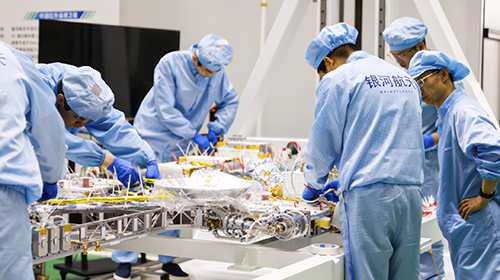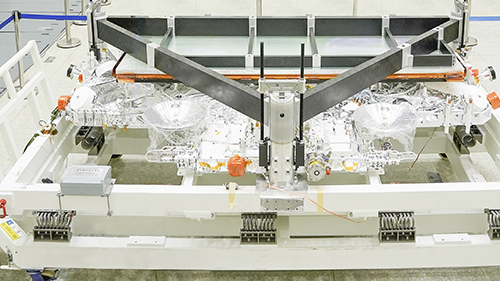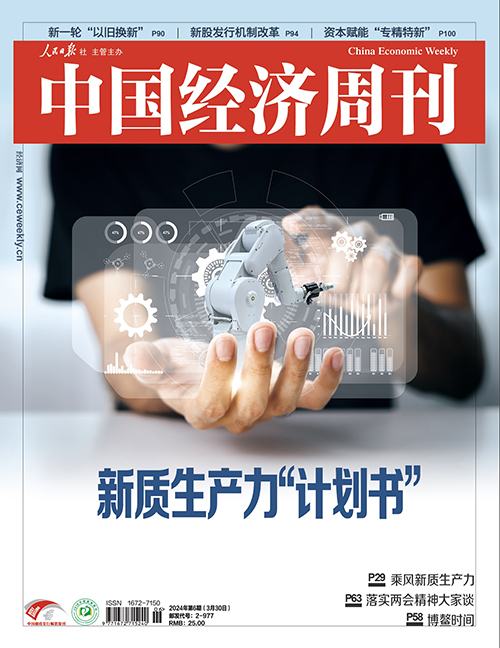China Economic Weekly reporter Jia Xuan | Beijing report
This year's government work report proposes to vigorously promote the construction of a modern industrial system and accelerate the development of new quality productivity. Actively cultivate emerging industries and future industries. Consolidate and expand the leading advantages in industries such as intelligent connected new energy vehicles, accelerate the development of cutting-edge emerging hydrogen energy, new materials, innovative drugs and other industries, and actively create new growth engines such as bio manufacturing, commercial aerospace, and low altitude economy.
This is the first time that commercial aerospace has been included in the government work report.
In fact, commercial aerospace has been mentioned at the Central Economic Work Conference to be held at the end of 2023. It was proposed at the meeting that "several strategic emerging industries such as bio manufacturing, commercial aerospace and low altitude economy should be built"
Commercial aerospace is one of the challenging and widely driven high-tech fields, which is characterized by high technology, high risk, high efficiency and long cycle. From "strategic emerging industry" to "new growth engine", the position of commercial aerospace in China's economic development is becoming clearer and more important.

China's commercial aerospace development has begun to take shape
In January this year, there was a huge roar in the sea area near Haiyang, Shandong Province. The Gravitational One Remote One commercial carrier rocket, developed by the private rocket company Dongfang Space, took off with three satellites and successfully completed its first flight.
Gravitation 1 has improved its carrying capacity to 5 to 6 tons through the innovation of rocket configuration and bundling technology, creating the record of the world's largest solid carrier rocket, and further enriching the carrier rocket type spectrum of China. At the same time, it has reduced the launch cost by more than 30%, facilitated the construction of large-scale satellite constellations, and expanded the diversified and large-scale launch capability of China's LEO satellites.
Through Gravity One, we can see the strong momentum of the rapid development of China's commercial aerospace. Commercial aerospace is an aerospace activity led by enterprises, which allocates technology, capital, talents and other resource elements according to market distribution rules, and is carried out for the purpose of profit and in accordance with market rules. Under a more flexible market mechanism, commercial aerospace can fully carry out technological exploration and innovation.
According to the Blue Book of China's Aerospace Science and Technology Activities (2023), China will complete 26 commercial launches in 2023, with a success rate of 96%; A total of 120 commercial satellites were developed and launched, accounting for 54% of the total number of satellites developed and launched throughout the year. The No. 1 launch station of Hainan International Commercial Space Launch Site has been completed, and the No. 2 station is accelerating its construction. The two stations will each have a launch capacity of 16 launches per year; Jiuquan Satellite Launch Center has added new commercial launch stations in recent years; Commercial aerospace TT&C companies such as Aerospace Yuxing have completed the construction of more than 20 sets of medium and large caliber ground stations, further improving the global ground station network.
Many experts believe that under the strong support of national policies and driven by market demand, China's commercial aerospace development has begun to take shape, covering many fields such as upstream rocket launch, satellite and ground equipment development, midstream satellite operation and downstream satellite application. China's commercial aerospace industry has stepped into a period of rapid development from its initial stage, which has become an important support for China's transformation from a "space power" to a "space power", and also injected new momentum into accelerating the development of new quality productivity.

The economic pull effect of commercial aerospace is obvious
"As a new growth engine, commercial aerospace has been written into the government work report for the first time, fully demonstrating its importance in developing new quality productivity. This has greatly inspired commercial aerospace enterprises to face the international frontier and accelerate scientific and technological innovation." Zhang Shijie, chief scientist of Galaxy Aerospace, told China Economic Weekly.
Zhang Shijie mentioned that the relevant data shows that the direct input-output ratio of the commercial aerospace industry is about 1 ∶ 2, and the direct pulling effect on the national economy is 8 to 14 times of the original input.
Fang Zheng, assistant to the general manager of the four-dimensional surveying and mapping company of China Aerospace Science and Technology Group, said in an interview with China Economic Weekly: "As an important part of the country's' new infrastructure ', commercial aerospace includes three major fields of' communication, navigation and remote ', with high technology content. The industrial chain covers the upstream, midstream and downstream of rockets and satellites from manufacturing to operation and application, with obvious economic pull effect."
Fang Zheng explained from the perspective of satellite applications. He said that commercial aerospace is a market-oriented enterprise that actively captures the needs of various users, provides matching space segment infrastructure construction and ground segment products and services, accelerates the optimal allocation of related resources through market means, and maximizes the market value of satellite applications, Make overall consideration of economic and social benefits.
Fang Zheng mentioned that in recent years, many local governments have successively issued relevant policies to encourage and support the high-quality development of commercial aerospace in all links of the whole industry chain. This time, commercial aerospace was written in the government work report for the first time, which will greatly support and encourage the industry to further grow, deepen and strengthen.
He said: "From the perspective of industrial development, this will accelerate the innovative development of commercial aerospace enterprises, drive the application landing and product integration of aerospace technology and different industries, and constantly open up new application scenarios and development models through 'aerospace+industry'."
Zhang Shijie said: "Commercial aerospace will help the development of new quality productivity and drive the leap of productivity."
He particularly mentioned that at present, the construction of new space infrastructure is accelerating, and the huge satellite networking and applications will form a new growth pole, driving the development of new generation information technology, high-end manufacturing, new energy, new materials and other high-tech industries. At the same time, commercial aerospace will also integrate with the new generation of artificial intelligence, big data, advanced computing and other technologies, and the industrial space application mode and form will continue to expand, bursting out a larger imagination.
Zhang Shijie believes that, as the main body of innovation, commercial aerospace enterprises can promote multi industry convergence innovation with market-oriented thinking mode and means, find the best combination point in innovation, reliability and cost, efficiently complete the process of product research and development, verification and other processes that adapt to the market, and make rapid feedback on global cutting-edge technology and market dynamics, To contribute to the space power and science and technology power under construction.
Between China's existing satellite resources and demand
There is still a large gap
In 2015, the National Development and Reform Commission, the Ministry of Finance, the National Administration of Science, Technology and Industry for National Defense and other departments jointly released the Medium and Long term Development Plan for National Civil Space Infrastructure (2015-2025), clearly encouraging private enterprises to develop commercial aerospace, and starting the transformation process of China Aerospace from a single government led to a combination of government led and market driven.
In 2016, the State Council issued the white paper 2016 China's Aerospace, marking the gradual liberalization of China's commercial aerospace policy. The policy began to encourage the development of private aerospace enterprises. Around the field of rockets and satellites, a number of private aerospace companies have emerged to test commercial aerospace.
After years of development, commercial aerospace has attracted more social capital, enterprises and scientific research institutions to participate in the industry with the continuous opening of industrial policies and the continuous support of governments at all levels, and the industry has officially entered the fast lane of development.
"China has initially formed a commercial aerospace industry chain for commercial aerospace, which integrates rocket assembly and general survey, satellite research and production, satellite measurement and operation control, satellite networking, and satellite data application." Zhang Shijie told reporters that from a technical perspective, China's many commercial rockets were successfully launched; Communication satellites, remote sensing satellites, SAR satellites (earth observation remote sensing satellites with synthetic aperture radar) developed by commercial companies have successfully entered orbit; The industry has made several domestic and international technological breakthroughs for the first time.
He mentioned in particular that it is worth noting that the advantages of China's mature industrial system are emerging, enabling each other with aerospace enterprises to meet industrial innovation and build a new aerospace industry ecology.
For example, the ground supporting enterprises, facing the order demand of commercial aerospace companies, carry out joint interactive design, development, testing and verification of products with large satellite companies. In this process, the productivity level of the whole chain is improved through technological innovation, which has become a new trend for industrial enterprises to transform and upgrade and stimulate new momentum.
"Commercial aerospace enterprises are accelerating the construction of new space infrastructure through technological innovation and constantly making new breakthroughs." Zhang Shijie mentioned that the application of flexible solar wing technology makes it possible for satellites to have "super large energy"; The development of attitude and orbit autonomous control technology makes the operation and management of large-scale constellation networking more efficient and convenient; The improvement of multi beam phased array antenna technology also makes the network access of "space computer" more flexible.
However, Fang Zheng also said frankly that in terms of the number of satellites in orbit, the existing resources cannot fully meet the market demand, or even there is a big gap. At present, China 4D is striving to build a new generation of commercial remote sensing satellite system, hoping to carry out diversified applications by providing massive remote sensing data to help commercial aerospace related industries.
The ultimate goal of commercial aerospace development is to benefit the public
Within this year, Hainan International Commercial Space Launch Center, China's first commercial space launch site, will realize normal launch. At the same time, a series of major commercial aerospace projects will continue to advance. Among them, the "new generation commercial remote sensing satellite system" will accelerate the construction; Several new launch vehicles, including Gravitation 1, made their first flight; The first commercial space launch site ushers in the first launch mission, and multiple satellite constellations will accelerate the networking construction.
Looking forward to the future, Zhang Shijie believes that China's commercial aerospace will continue to move towards high-quality development, continue to increase investment in research and development, give play to the advantages of small steps and fast iterations, accelerate the pace of technological innovation and industrial upgrading, and strive to become a new force in building a powerful aerospace country.
Fang Zheng believes that commercial spaceflight will change our lives more and more profoundly and directly, which is expected to make transportation more convenient, crops more healthy, cities more intelligent, and disaster damage more controllable... "In other words, commercial spaceflight must take the benefit of the public as the ultimate goal of development, which is also the reason why we are confident in our undertakings."
At the same time, the degree of marketization of commercial aerospace will become higher and higher, and related technical barriers will rise instead of fall. "It is believed that there will be more and more excellent enterprises and talents pouring into China's commercial aerospace industry. These enterprises and talents will not only come from aerospace professional fields, but also from non-traditional aerospace fields, further integrating commercial aerospace into the market-oriented construction." Fang Zheng said.

(This article was published in the 6th issue of China Economic Weekly in 2024)





